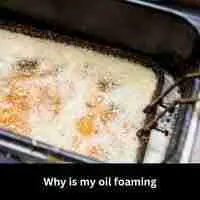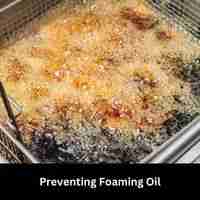Why is my oil foaming. Oil foaming is a common problem that many people experience, especially when using machinery or vehicles that require oil for lubrication.
Foaming can occur due to a variety of reasons, ranging from the type of oil being used, the operating conditions of the machine, or even the design of the oil system itself.
Regardless of the cause, oil foaming can have serious consequences, such as reduced lubrication efficiency, increased wear and tear on components, and even system failure.
In this article, we will explore some of the most common reasons why oil foaming occurs, as well as some of the potential solutions that can help you avoid this problem and keep your machinery running smoothly.
Why is my oil foaming
We will discuss here the causes of foaming oil:
1. Overfilling
One of the most common causes of foaming oil is overfilling. If you add too much oil to your engine or hydraulic system, it can create air pockets that cause foaming.
This is because the moving parts in the system can churn the excess oil, causing it to mix with air and create bubbles.
2. Contamination
Contamination of the oil can also cause it to foam. If dirt, debris, or water gets into the oil, it can create air pockets and cause the oil to foam.
This can be particularly problematic in hydraulic systems, where the foaming oil can cause cavitation and damage the system.
3. High Temperatures
When oil gets too hot, it can start to break down and produce gas bubbles. This is particularly common in engines, where the high temperatures generated by combustion can cause the oil to foam.
In some cases, this can even lead to oil starvation, as the foam can prevent the oil from lubricating critical engine parts.
4. Agitation
Any time oil is agitated, it can create air pockets and cause foaming. This can happen in hydraulic systems when the fluid is pumped rapidly or in engines when the oil is whipped around by moving parts.
This is why it’s important to use high-quality oil that is specifically formulated for your application, as it will be less likely to foam under these conditions.
5. Additives
Some oil additives can also cause foaming. For example, some anti-wear additives contain zinc or phosphorous, which can react with the oil and produce gas bubbles. This is more common in older engines or in applications that use outdated oil formulations.
Solutions to Foaming Oil
1. Check the Oil Level
If you suspect that overfilling is causing the oil to foam, the first step is to check the oil level. If it’s too high, drain off the excess oil until the level is within the recommended range.
2. Change the Oil
If the oil is contaminated or has been in use for too long, it may be time to change it. Be sure to use the recommended oil for your application and replace any filters as well.
3. Address High Temperatures
If high temperatures are causing the oil to foam, you may need to address the root cause of the problem. This could involve improving engine cooling, fixing a faulty thermostat, or using a different type of oil that is better suited to high-temperature applications.
4. Reduce Agitation
If agitation is causing the oil to foam, you may be able to reduce it by changing the way your machinery operates.
For example, you may be able to adjust the speed or flow rate of a hydraulic pump to reduce turbulence. In engines, using an oil with a higher viscosity may help reduce foaming.
5. Avoid Additives
If you suspect that additives are causing the oil to foam, you may need to switch to an oil that doesn’t contain them.
Alternatively, you may be able to find an oil additive that is less likely to cause foaming, or use an alternative type of additive altogether.
6. Use a Defoaming Agent
In some cases, it may be necessary to use a defoaming agent to prevent oil from foaming. Defoaming agents are chemical additives that break down foam and prevent it from forming.
However, it’s important to use these agents with caution, as they can also affect the performance of the oil and may not be suitable for all applications.
7. Consult a Professional
If you’re unsure about the cause of foaming oil or how to fix it, it’s always a good idea to consult a professional.
A mechanic or engineer with experience in your particular type of machinery can help diagnose the problem and recommend the best course of action.
Preventing Foaming Oil
While there are many solutions to foaming oil, prevention is always better than a cure. Here are some tips for preventing oil from foaming in the first place:
1. Use the Correct Oil
Using the correct type of oil for your application is essential for preventing foaming.
Be sure to consult your owner’s manual or a professional to determine the right type of oil for your engine or machinery.
2. Maintain the Oil Level
As we’ve mentioned, overfilling can cause oil to foam. Be sure to check and maintain the oil level regularly to avoid this problem.
3. Keep the Oil Clean
Contaminants like dirt, debris, and water can cause oil to foam. Regularly changing the oil and filters, as well as keeping your machinery clean, can help prevent this problem.
4. Monitor Temperatures
High temperatures can cause oil to foam, so it’s important to monitor engine or machinery temperatures and take steps to reduce them if necessary.
5. Avoid Agitation
Avoiding unnecessary agitation of the oil, such as rapid pumping or high-speed operation, can help prevent foaming.
FAQs
How can I prevent oil from foaming?
To prevent oil from foaming, it is important to avoid overheating the oil, minimize agitation, and ensure that the oil is free from contaminants.
In cooking applications, using a pot or pan with a lid can help reduce agitation and prevent oil from splattering.
In lubricating applications, regular oil analysis and maintenance can help identify and address potential issues before they become more serious.
What can I do if my oil is already foaming?
If your oil is already foaming, the best course of action will depend on the specific situation. In some cases, simply removing the source of agitation or reducing the temperature of the oil can be enough to stop foaming.
In other cases, it may be necessary to filter or replace the oil altogether. If you are experiencing foaming in a lubricating oil, it is important to address the issue promptly to prevent damage to machinery.
Are there any additives that can help prevent oil foaming?
Yes, there are a number of different additives that can help reduce or prevent oil foaming, depending on the specific application.
For example, antifoaming agents can be added to lubricating oils to help reduce the formation of foam, while emulsifiers can help prevent the separation of oil and water in cooking applications.
It is important to choose the right additive for your specific application and to follow the manufacturer’s instructions carefully.
Conclusion
In conclusion, oil foaming can be caused by several factors such as aeration, agitation, contaminants, and chemical reactions. It can result in a decrease in lubrication efficiency, which can lead to damage or failure of equipment. To prevent oil foaming, it is essential to maintain the proper level of oil in the equipment, reduce agitation and aeration, and remove contaminants from the oil. It is also important to use the correct type of oil and ensure that the equipment is operating within its design limits.
Regular oil analysis can help detect and identify the cause of foaming and allow for appropriate corrective action to be taken. Overall, understanding the causes of oil foaming and taking proactive measures to prevent it can help ensure the reliable and efficient operation of equipment.
Related Guides




